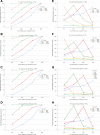Easing or tightening control strategies: determination of COVID-19 parameters for an agent-based model
- PMID: 34276105
- PMCID: PMC8275455
- DOI: 10.1007/s11116-021-10210-7
Easing or tightening control strategies: determination of COVID-19 parameters for an agent-based model
Abstract
Some agent-based models have been developed to estimate the spread progression of coronavirus disease 2019 (COVID-19) and to evaluate strategies aimed to control the outbreak of the infectious disease. Nonetheless, COVID-19 parameter estimation methods are limited to observational epidemiologic studies which are essentially aggregated models. We propose a mathematical structure to determine parameters of agent-based models accounting for the mutual effects of parameters. We then use the agent-based model to assess the extent to which different control strategies can intervene the transmission of COVID-19. Easing social distancing restrictions, opening businesses, speed of enforcing control strategies, quarantining family members of isolated cases on the disease progression and encouraging the use of facemask are the strategies assessed in this study. We estimate the social distancing compliance level in Sydney greater metropolitan area and then elaborate the consequences of moderating the compliance level in the disease suppression. We also show that social distancing and facemask usage are complementary and discuss their interactive effects in detail.
Keywords: Agent-based disease spread model; Compliance level; Control strategies; Facemask; Social distancing.
© The Author(s), under exclusive licence to Springer Science+Business Media, LLC, part of Springer Nature 2021.
Conflict of interest statement
Conflicts of interestAll authors have seen and approved the manuscript and have contributed significantly to the paper. Also, the authors declare that they have no conflict of interest.
Figures










References
-
- Ahn H. Central composite design for the experiments with replicate runs at factorial and axial points. Springer; 2015. pp. 969–979.
-
- Aleta A, Martín-Corral D, Piontti APY, Ajelli M, Litvinova M, Chinazzi M, Dean NE, Halloran ME, Longini IM, Merler S, Pentland A, Vespignani A, Moro E, Moreno Y. Modeling the impact of social distancing, testing, contact tracing and household quarantine on second-wave scenarios of the COVID-19 epidemic. MedRxiv. 2020 doi: 10.1101/2020.05.06.20092841. - DOI - PMC - PubMed
LinkOut - more resources
Full Text Sources
